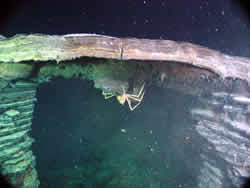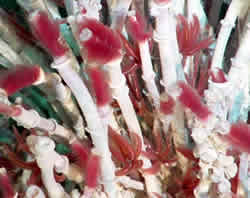|

Teacher's Report
Bill Hanshumaker, Educator at Sea

A spider
crab hangs from an arch between two lava pillars. |
|
In addition to being posted on the NeMO
website, these journal entries are being used in auditorium presentations
conducted daily at the Hatfield
Marine Science Center (HMSC) in Newport, Oregon. HMSC's Visitor Center
informs and educates over 130,000 people annually about the research conducted
by Oregon State University and other state and federal agencies such as
NOAA's EOI Program. Participants in the auditorium presentations are
offered the opportunity to direct questions to the researchers and educators
at sea. Here are some of the questions:
Does the hydrothermal plume reach the
surface?
A hydrothermal plume is produced by volcanic activity on the ocean bottom.
These events range in magnitude from the venting of hot water heated by
the magma beneath the surface, to an eruption of an undersea volcano.
Currents, the depth of the ocean, and the magnitude of the volcanic event
can all effect how rapidly this heated water disperses. Generally, as
long as there is a temperature difference between the hydrothermal plume
and the surrounding ocean, the hydrothermal plume will rise. Because of
the depth of the ocean, the hydrothermal plumes usually do not reach the
surface.
| |

Healthy tubeworms and palmworms near Marker-33
vent. |
How are these undersea volcanoes related
to Mt. St. Helens?
Axial Volcano, the site we are studying, is at a spreading center where
the giant Pacific plate and smaller Juan de Fuca plate are moving apart.
The Juan de Fuca plate is moving east and subducting, or moving under,
the North American plate. As this material moves deeper beneath the crust,
some of it melts. This molten material then rises to the surface and forms
the volcanic Cascade Range, where Mt. St. Helens is located.
How far offshore is the subduction zone?
The subduction zone is at the base of the continental slope, approximately
60 miles (100 kilometers) off the coast of Oregon and Washington.
Are most of the volcanoes on earth underwater?
Most of the volcanoes on earth are found at the mid-oceanic ridge that
girdles the globe like the seams of a baseball.
So, in addition to shaking, can the
ground drop in an earthquake?
Yes, especially in subduction zones, and we can see this evidence in different
ways. Direct evidence of ground movement was immediately visible after
the Alaskan earthquake in 1964. Offshore, tsunamis are sometimes generated
by submarine landslides, which create large waves as they approach the
shore. Indirect evidence includes groves of dead Sitka spruce that are
still standing in water on the Oregon coastline. Recent beach erosion
there has also uncovered stumps of trees that were buried by subsidence
during earthquakes thousands of years ago.
How does the sulfide get into the tubeworm
if it has no mouth?
Hydrothermal vent tubeworms have neither a mouth nor anus. Rather than
a digestive track, these amazing animals rely on bacteria living inside
a specialized organ called a trophosome to produce the nutrients necessary
for life. The bacteria use the hydrogen sulfide found in the hydrothermal
vent waters. Hydrogen sulfide yields considerable energy when oxidized
by the bacteria. Hydrogen sulfide is taken up by the worm's gill-like
red plume and is transported to the bacteria via hemoglobin in its blood.
This mutualistic type of symbiosis benefits both the bacteria (they get
a place to live) and the tubeworm.
Are the bacteria in the tubeworms aerobic
or anaerobic?
Aerobic animals require oxygen for respiration, while anaerobic animals
do not. The bacteria that live inside of hydrothermal tubeworms are aerobic
and require oxygen. The tubeworm provides the oxygen, using hemoglobin
to transport it from its gills where it is extracted from the surrounding
seawater. Tubeworm hemoglobin is unique as it can simultaneously transport
both hydrogen sulfide and oxygen. Humans are poisoned by hydrogen sulfide
since it binds to our hemoglobin and renders it incapable of transporting
oxygen.
How do the worms get bacteria inside?
There are two possibilities. Either the symbiont acquisition is passed
from generation to generation (vertical) or the bacteria are acquired
from the external environment (horizontal). In vent clams (Calyptogena
magnifica) molecular techniques revealed that the symbiotic bacteria is
passed vertically from the mother via the egg. Though the results are
still controversial, juvenile tubeworms most likely acquire their symbiotic
bacteria directly from the environment.
|

